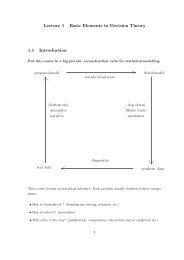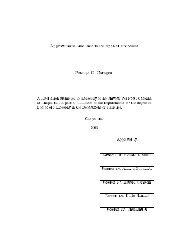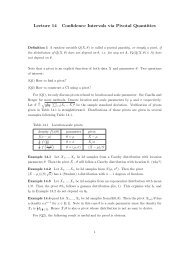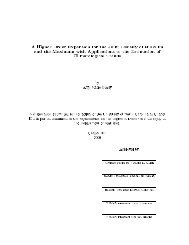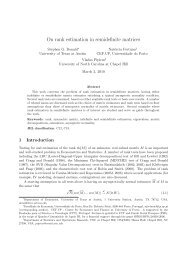Monte Carlo Methods in Statistical Mechanics: Foundations and ...
Monte Carlo Methods in Statistical Mechanics: Foundations and ...
Monte Carlo Methods in Statistical Mechanics: Foundations and ...
You also want an ePaper? Increase the reach of your titles
YUMPU automatically turns print PDFs into web optimized ePapers that Google loves.
also of practical importance. b C(t) isanunbiased estimator of C(t), <strong>and</strong> b C(t) is almost<br />
unbiased (the bias is of order 1=n) [15, p. 463]. Their variances <strong>and</strong> covariances are [15,<br />
pp. 464{471] [14, pp. 324{328]<br />
1X<br />
var( b C(t)) = 1<br />
n m=;1<br />
+ o 1<br />
n<br />
cov( b C(t) b C(u)) = 1<br />
n<br />
1X<br />
h C(m) 2 + C(m + t)C(m ; t)+ (t m m + t) i<br />
[C(m)C(m + u ; t)+C(m + u)C(m ; t)<br />
m=;1<br />
+ (t m m + u)] + o 1<br />
n<br />
where t u 0<strong>and</strong> is the connected 4-po<strong>in</strong>t autocorrelation function<br />
(3.10)<br />
(3.11)<br />
(r st) h(fi ; )(fi+r ; )(fi+s ; )(fi+t ; )i<br />
; C(r)C(t ; s) ; C(s)C(t ; r) ; C(t)C(s ; r) : (3.12)<br />
To lead<strong>in</strong>g order <strong>in</strong> 1=n, the behavior of b C is identical to that of b C.<br />
The \natural" estimator of (t) is<br />
if the mean is known, <strong>and</strong><br />
b(t) b C(t)= b C(0) (3.13)<br />
b(t)<br />
bC(t)= b C(0) (3.14)<br />
if the mean is unknown. The variances <strong>and</strong> covariances of b(t) <strong>and</strong> b(t) canbe<br />
computed (for large n) from (3.11) we omitthe detailed formulae.<br />
The \natural" estimator of <strong>in</strong>t would seem to be<br />
b <strong>in</strong>t<br />
? 1<br />
2<br />
n X;<br />
1<br />
t = ;(n ; 1)<br />
b(t) (3.15)<br />
(or the analogous th<strong>in</strong>g with b), but this is wrong! The estimator de ned <strong>in</strong> (3.15) has a<br />
variance that doesnotgoto zero as the sample size n goes to <strong>in</strong> nity [14, pp. 420{431],<br />
so it is clearly a very bad estimator of <strong>in</strong>t. Roughly speak<strong>in</strong>g, this is because the sample<br />
autocorrelations b(t) for jtj conta<strong>in</strong> much \noise" but little \signal" <strong>and</strong> there are<br />
so many ofthem (order n) that the noise adds up to atotal variance of order 1. (For a<br />
more detailed discussion, see [14, pp. 432{437].) The solution is to cuto the sum<strong>in</strong><br />
(3.15) us<strong>in</strong>g a \w<strong>in</strong>dow" (t) whichis 1forjtj < but 0 for jtj :<br />
b <strong>in</strong>t<br />
1<br />
2<br />
n X;<br />
1<br />
t = ;(n ; 1)<br />
15<br />
(t) b(t) : (3.16)



